David McFall R.A. (1919 - 1988)
Sculptor
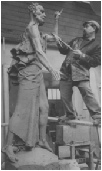
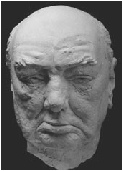
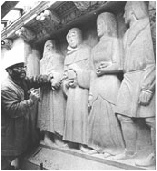
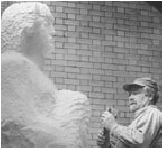

1968/4 Sir Winston S Churchill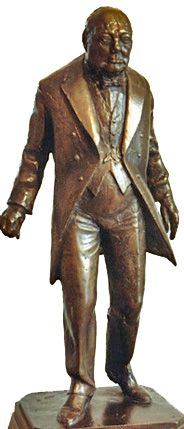
Height 13" excluding base 15 1/2" including base
Bronze
Statuette - trophy for Dame Felicity Peake Essay Prize
Commissioned by Dame Felicity Peake and presented to the Imperial War Museum (of which she was Chairman) as a prize for schools visiting the museum and writing essays on a given subject relating to their visits. The winning school would retain the trophy for the intervening period, usually 2 years, before the next competition. The winners were also given selected books to keep.
Second cast in possession of Dame Peake: "The statuette is so brilliant that my late husband and I asked David if he could produce one copy for us to retain. I am happy to say that it sits in a place of honour in my flat in London to this day” (1993)
Obituary: Air Commodore Dame Felicity Peake
Independent, The (London), Dec 5, 2002 by Max Arthur
IN 1946 Felicity Hanbury was appointed Director of the Women's Auxiliary Air Force at the remarkable young age of 33. Her sheer personality, drive and leadership qualities, coupled with her wartime experience, also made her an ideal choice, in 1949, as the first Director of the new Women's Royal Air Force.
In the 1969 film Battle of Britain Susannah York played a young WAAF officer at RAF Biggin Hill during the Battle of Britain. There is a moving scene after a heavy raid on the station where York is seen moving among the killed and wounded WAAFs. Her part was based on the experience of Hanbury. She had been a section officer in charge of 250 WAAFs and lost 39 of her section on that particular raid.
Felicity Hanbury (later Peake) was born Felicity Watts, in 1913. Her father, Col Humphrey Watts, was a prosperous Manchester textile merchant. Not an academic child, she left St Winifred's, Eastbourne, without taking her school certificate and completed her education at a finishing school in France. She was presented at Court in 1933 and then was invited by an uncle to accompany him on a cruise to the West Indies.
In the heady atmosphere aboard ship the young Felicity Watts met Jock Hanbury, a director of the brewers Truman, Hanbury and Buxton. They were married two years later at St Margaret's, Westminster, and honeymooned in Monte Carlo. Both were keen on flying and soon obtained their licence. With war imminent her husband joined the RAF, but, with less than 25 hours' flying time, she was disappointed to be rejected by the Air Transport Auxiliary, whose main task was to ferry aircraft.
In April 1939, in typical fashion, she put her setback aside and joined the ranks as an Aircraftwoman in the WAAF, but was commissioned at the outbreak of war. Tragedy struck only a month later, when her husband was killed during a night-flying exercise.
She threw herself into her new work as a cipher officer, but decided this was not absorbing enough and sought out an administrative post at Biggin Hill, an operations station, which was very much to be at the heart of the Battle of Britain. With the battle over, she joined the WAAF recruiting staff at the Air Ministry in London.
This tall, very attractive young officer then toured the country in the back of a van with a hailer and so impressed with her were the Air Ministry that they promoted her and re-assigned her to public- relations duties. She captivated the press and changed the attitude of many dyed-in-the- wool senior RAF officers, most of whom couldn't see the need for women officers in the Service. One of her greatest victories was to win over the Chief of the Air Staff, Sir Charles Portal, with whom she worked closely. Also attracted to her warmth, determination and perception was her boss, Air Commodore Harald (later Sir Harald) Peake. He was wise enough not only to hand over to her the responsibility for PR of the Waaf, but to marry her 10 years later.
In 1943 Felicity Hanbury was then posted to Bomber Command, where she encountered Sir Arthur "Bomber" Harris. She had been warned that he did not take kindly to women, but she knew her job and when necessary stood up to Harris, who admired her and invited her to dinner with his wife.
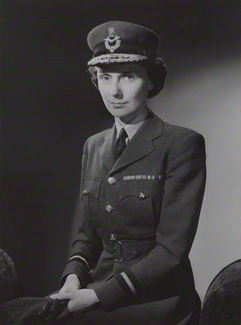
Amidst a high level of jealousy among the more senior figures in the WAAF, who felt she was being favoured for the post of Director of the Waaf, it was decided that it would be given to an older woman, Lady Welsh. In compensation, Hanbury took over command of the Waaf in Europe and the Middle East.
To her immense satisfaction in 1946 she became Director of the WAAF. She successfully saw it through its evolution into a peacetime role and was the natural choice of Director when the Women's Royal Air Force was established. For her work during the period and still only 36, she was appointed DBE.
A year later she retired from the Wraf and joined the Board of Truman, Hanbury and
Buxton. In 1952 she married Harald Peake and toget her they bought a farm in Oxford
and travelled frequently to France, which she always regarded as her spiritual home.
her they bought a farm in Oxford
and travelled frequently to France, which she always regarded as her spiritual home.
For many years and with many memories of grimmer times, she became active on the executive committee of the RAF Benevolent Fund. After becoming a trustee of the Imperial War Museum, she founded the museum's Friends, and later became their President. She published her memoirs, Pure Chance, in 1993.
Felicity Hyde Watts, air-force officer: born Cheadle Hulme, Cheshire 1 May 1913; MBE 1941, DBE 1949; Director, Women's Auxiliary Air Force 1946-49; Director, Women's Royal Air Force 1949-50;
Hon ADC to King George VI 1949-50; Chairman, Friends of the Imperial War Museum 1986-88,
President 1988-92; married 1935 Jock Hanbury (died 1939), 1952 Harald Peake (Kt 1973, died 1978;
one son); died London 2 November 2002.
All rights reserved
© National Portrait Gallery, London
| Animals |
| Busts and Heads |
| Children |
| Churchill studies |
| Lettering |
| Medals coins plates |
| Reliefs |
| Stone carvings |
| Contemporary British Artists |
| On Epstein |
| Picasso |
| The art of portrait sculpture |
| Letters |
| Palliser |
| Son of Man |
| Press |
| Obituaries |
| Memorial address |